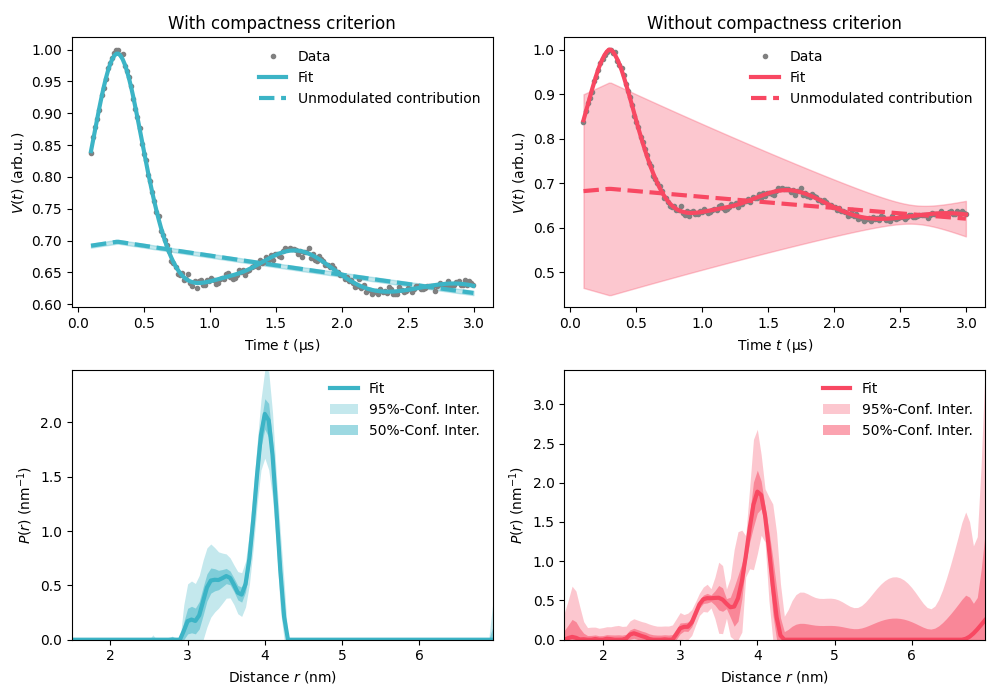Note
Go to the end to download the full example code.
Comparing the analysis with and without compactness criterion¶
This examples shows how to quickly compare the effects of the compactness criterion on the results of the analysis of a 4-pulse DEER signal.
import numpy as np
import matplotlib.pyplot as plt
import deerlab as dl
# File location
path = '../data/'
file = 'example_4pdeer_1.DTA'
# Experimental parameters
tau1 = 0.3 # First inter-pulse delay, μs
tau2 = 4.0 # Second inter-pulse delay, μs
tmin = 0.1 # Start time, μs
# Load the experimental data
t,Vexp = dl.deerload(path + file)
# Pre-processing
Vexp = dl.correctphase(Vexp) # Phase correction
Vexp = Vexp/np.max(Vexp) # Rescaling (aesthetic)
t = t - t[0] # Account for zerotime
t = t + tmin
# Artifically truncate the signal
Vexp = Vexp[t<=3]
t = t[t<=3]
# Distance vector
r = np.arange(1.5,7,0.05) # nm
# Construct the model
Vmodel = dl.dipolarmodel(t,r, experiment=dl.ex_4pdeer(tau1,tau2, pathways=[1]))
compactness = dl.dipolarpenalty(Pmodel=None,r=r,type='compactness')
# Fit the model to the data with compactness criterion
results_with = dl.fit(Vmodel,Vexp,penalties=compactness)
print(results_with)
# Fit the model to the data without compactness criterion
results_without = dl.fit(Vmodel,Vexp)
print(results_without)
Goodness-of-fit:
========= ============= ============= ===================== =======
Dataset Noise level Reduced 𝛘2 Residual autocorr. RMSD
========= ============= ============= ===================== =======
#1 0.005 0.741 0.005 0.004
========= ============= ============= ===================== =======
Model hyperparameters:
========================== ===================
Regularization parameter Penalty weight #1
========================== ===================
0.021 0.240
========================== ===================
Model parameters:
=========== ========= ========================= ====== ======================================
Parameter Value 95%-Confidence interval Unit Description
=========== ========= ========================= ====== ======================================
mod 0.298 (0.295,0.301) Modulation depth
reftime 0.300 (0.298,0.303) μs Refocusing time
conc 153.223 (153.223,153.223) μM Spin concentration
P ... (...,...) nm⁻¹ Non-parametric distance distribution
P_scale 0.994 (0.992,0.996) None Normalization factor of P
=========== ========= ========================= ====== ======================================
Goodness-of-fit:
========= ============= ============= ===================== =======
Dataset Noise level Reduced 𝛘2 Residual autocorr. RMSD
========= ============= ============= ===================== =======
#1 0.005 0.685 0.147 0.004
========= ============= ============= ===================== =======
Model hyperparameters:
==========================
Regularization parameter
==========================
0.025
==========================
Model parameters:
=========== ========= ========================= ====== ======================================
Parameter Value 95%-Confidence interval Unit Description
=========== ========= ========================= ====== ======================================
mod 0.313 (0.074,0.553) Modulation depth
reftime 0.299 (0.298,0.301) μs Refocusing time
conc 121.992 (0.010,692.530) μM Spin concentration
P ... (...,...) nm⁻¹ Non-parametric distance distribution
P_scale 1.001 (0.963,1.038) None Normalization factor of P
=========== ========= ========================= ====== ======================================
# Define colors
green = '#3cb4c6'
red = '#f84862'
colors = [green,red]
plt.figure(figsize=[10,7])
for n,results in enumerate([results_with, results_without]):
# Extract fitted dipolar signal
Vfit = results.model
# Extract fitted distance distribution
Pfit = results.P
Pci95 = results.PUncert.ci(95)
Pci50 = results.PUncert.ci(50)
# Extract the unmodulated contribution
Bfcn = lambda mod,conc,reftime: results.P_scale*(1-mod)*dl.bg_hom3d(t-reftime,conc,mod)
Bfit = results.evaluate(Bfcn)
Bci = results.propagate(Bfcn).ci(95)
plt.subplot(2,2,n+1)
# Plot experimental and fitted data
plt.plot(t,Vexp,'.',color='grey',label='Data')
plt.plot(t,Vfit,linewidth=3,color=colors[n],label='Fit')
plt.plot(t,Bfit,'--',linewidth=3,color=colors[n],label='Unmodulated contribution')
plt.fill_between(t,Bci[:,0],Bci[:,1],color=colors[n],alpha=0.3)
plt.legend(frameon=False,loc='best')
plt.xlabel('Time $t$ (μs)')
plt.ylabel('$V(t)$ (arb.u.)')
plt.title('With compactness criterion' if n==0 else 'Without compactness criterion')
# Plot the distance distribution
plt.subplot(2,2,n+3)
plt.plot(r,Pfit,color=colors[n],linewidth=3,label='Fit')
plt.fill_between(r,Pci95[:,0],Pci95[:,1],alpha=0.3,color=colors[n],label='95%-Conf. Inter.',linewidth=0)
plt.fill_between(r,Pci50[:,0],Pci50[:,1],alpha=0.5,color=colors[n],label='50%-Conf. Inter.',linewidth=0)
plt.legend(frameon=False,loc='best')
plt.autoscale(enable=True, axis='both', tight=True)
plt.xlabel('Distance $r$ (nm)')
plt.ylabel('$P(r)$ (nm$^{-1}$)')
plt.tight_layout()
plt.show()

Total running time of the script: (3 minutes 20.504 seconds)